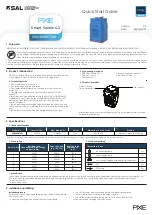
st
eut
e T
echnol
ogies GmbH & Co. K
G
Brück
ens
tr
aße 91, 32584 Löhne, Germany
, www
.s
teut
e.c
om
5 / 32
Montage- und Anschlussanleitung / Funk-Universalsender
Mounting and wiring instructions / Wireless universal transmitter
Instructions de montage et de câblage / Émetteur universel sans fil
Istruzioni di montaggio e collegamento / Trasmettitore universale wireless
Instruções de montagem e instalação / Transmissor universal sem fio
Инструкция по монтажу и подключению / Универсальный радио-передатчик
//
Ex RF 96 ST SW868/SW915
English
Safety notes
1. Use steute batteries of type Ex RF BAT 3.6 V with the EC type test
certificate BVS 18 ATEX E 035 X, IECEx BVS 18.0056X only.
2. Modifications of or repairing the battery are not allowed.
3. The above mentioned batteries are intrinsically safe and thus may
also be replaced within the hazardous area. When handling batter-
ies within the hazardous area, exercise due care. Avoid short-cir-
cuits or damage of the battery. In hazardous areas, transport the
batteries in suitable, electrically insulated packaging only.
4. The battery replacement must be exclusively carried out by author-
ised personnel. The authorised personnel must have knowledge
about protection methods, prescriptions for equipment for hazard-
ous area and its Ex marking.
5. Do not use visibly damaged batteries. Keep away from
hazardous areas.
6. Install and remove the battery manually only.
Do not use any tools.
7. Observe the operating instructions of the batteries.
Mounting notes
Mounting notes for inductive Ex wireless inductive sensors series
Ex RF IS M** nb-ST Xm. Ex wireless inductive sensors Ex RF IS M**
nb-ST Xm are installed non-flush only. For the installation, observe
the following conditions, »Free space«, »Reciprocal influence«,
»Tightening torque«, and »Front surface«.
Free space
With Ex wireless inductive sensors, the function principles are based
on the influence of a stray electromagnetic field. Because this stray
field does not only interfere with the object to be dectected , but also
with other conductive objects and also interferes with other Ex wire-
less inductive sensors, observe some mounting conditions. Opposite
the active surface, the minimum distance to/of a conductive surface
is 3 x sn.
Ill. 1: Free space around a cylindric non-flush Ex wireless inductive
sensor Ex RF IS M** nb-ST Xm and distance to an opposite
conductive surface.
Metal
A
active surface
d
diameter
sn rated switching
distance
1
free space
In individual cases, test the wireless range with the field strength
testing tool:
Transmitter
Device
Material number
SW868
swView 868 MHz
1190393
SW915
swView 915 MHz
1221794
Use the field strength testing tool in non-hazardous areas only (near
the receiver).
Special conditions and »X«-Marking
=
WARNING
Danger caused by electrostatic discharge.
Explosion hazard!
Avoid electrostatic discharge.
- For use in potentially explosive gas atmospheres, the wireless uni-
versal transmitter must be set up in such a way that dangerous elec-
trostatic charging is not to be expected.
- For use in dust explosion hazardous areas, the wireless universal
transmitter must be set up in such a way that sliding handle bush
charges are not to be expected.
- The wireless inductive sensors type Ex RF IS M** nb-ST Xm are to
be included in the equipotential bonding via installation in a metal
holder, see Ill. 1.
- The external sensors must be included in the equipotential bonding.
N.B.
The transmission of a switching command from the transmitter to the
receiver takes about 80 to 100 ms, based on the sWave® data trans-
mission. The switching signal of a transmitter must not be generated
in a shorter time interval. Otherwise this signal will be suppressed.
Subject to technical modifications. Reconstruction and alterations to
the device are not allowed. steute does not assume any liability for
recommendations made or implied by this description. New claims for
guarantee, warranty or liability cannot be derived from this document
beyond the general terms and conditions of delivery.
Maintenance
With rough conditions, we recommend routine maintenance as follows:
1. Remove all dirt particles.
2. Clean with a damp cloth only.
3. To replace the battery:
- Loosen the cover screws with a wrench.
- Remove the cover.
- Insert the battery according to the positive terminal marking.
- Mount the cover.
- Insert the cover screws.
- Tighten the cover screws.






































